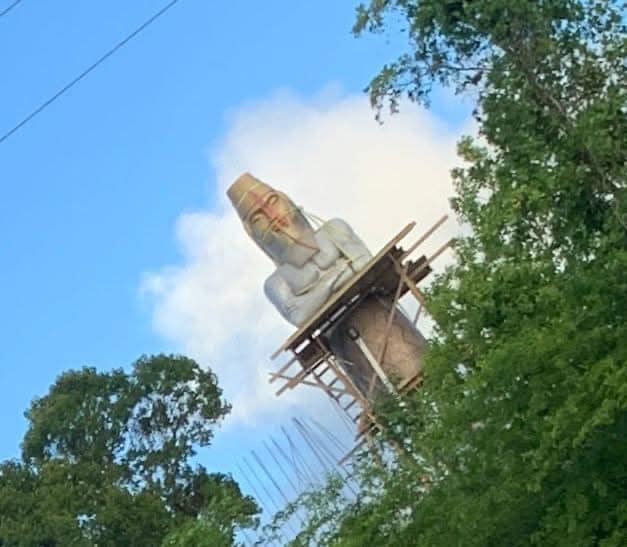
CLICK HERE TO JOIN OUR WHAT’S APP GROUP
In a recent social media post, Pastor K. Doyle of the Seventh-day Adventist Church shared a thought-provoking explanation titled “A Rationale for Building a Replica of the Image in Daniel 2.”
His statement aims to bring theological understanding and calm to what has become a heated discussion among local church communities over the controversial statue.
According to Pastor Doyle, the purpose of constructing a replica of the Daniel 2 image is not for worship, but rather for education and spiritual reflection.
He explained that the statue serves as a visual representation of God’s sovereignty over human kingdoms, reminding believers that all earthly powers will eventually fall, and God’s eternal kingdom will stand forever.
“A church may choose to build a replica of the image in Daniel 2 to visually illustrate the prophetic message of God’s sovereignty over earthly kingdoms,” Pastor Doyle wrote.
“It serves as a tangible reminder of God’s kingdom that will ultimately replace human empires, encouraging the congregation to trust in God’s eternal plan.”
Five Benefits Highlighted by Pastor Doyle
1. Educational Tool: Helps members understand prophecy and God’s control over history (Daniel 2:44).
2. Evangelistic Opportunity: Invites curiosity and discussion about biblical prophecy and Christ’s return.
3. Spiritual Reminder: Reinforces that God’s kingdom is everlasting (Daniel 2:35).
4. Motivates Faith: Strengthens believers’ confidence that God’s kingdom will outlast all earthly powers (Psalm 146:3-4).
5. Community Engagement: Fosters shared experiences that build unity and faith among members.
However, Pastor Doyle was careful to acknowledge that there are potential disadvantages to consider.
Two Possible Disadvantages
1. Misinterpretation: In cultures where religious images are uncommon, replicas may be misunderstood, leading to accusations of idolatry (Exodus 20:4).
2. Legal or Cultural Conflicts: In regions where public religious symbols are restricted, such displays could spark controversy or legal disputes, shifting attention away from the gospel’s message.
Doyle further clarified the biblical foundation for his reasoning by outlining the Commandment in Exodus 20:4–5, which prohibits making or worshiping graven images. He emphasized that the sin lies not in the creation of an image, but in the act of worshiping or serving it.
“The biblical context is that God’s people should not make any graven image for the purpose of worshiping it,” he wrote.
“Making images of anything is not inherently sinful; it is the worshiping of the image that God forbids.”
As the discussion continues, one of the central questions now being raised is whether Antiguan law prohibits the erection of such a statue. Legal experts and community leaders are being called upon to provide clarity on this matter.
For now, Pastor Doyle’s balanced approach has brought a measure of theological insight and calm to a debate that has caused significant division within the Christian community.
Many hope his explanation will help shift the focus back to understanding prophecy and promoting unity rather than contention.
CLICK HERE TO JOIN OUR WHAT’S APP GROUP
CLICK HERE TO JOIN OUR WHAT’S APP GROUP
CLICK HERE TO JOIN OUR WHAT’S APP GROUP
CLICK HERE TO JOIN OUR WHAT’S APP GROUP
CLICK HERE TO JOIN OUR WHAT’S APP GROUP
CLICK HERE TO JOIN OUR WHAT’S APP GROUP
CLICK HERE TO JOIN OUR WHAT’S APP GROUP
CLICK HERE TO JOIN OUR WHAT’S APP GROUP
Advertise with the mоѕt vіѕіtеd nеwѕ ѕіtе іn Antigua!
We offer fully customizable and flexible digital marketing packages.
Contact us at [email protected]


















This is absolute clarity to the nonsense propagated by the group Christians United, certain Pastors and by certain radio personalities. A statue per se is not IDOLATRY, it is if you pray to and worship the statue that is a sin. As far as I am aware, all the Christians of Antigua’ and Barbuda pray to Jesus Christ (that is depicted in images in churches to be Caucasian) and to his father God who supposedly lives in the sky. I hope the group United Christians and all the others who are opposed to the statue find more meaningful and worthwhile causes in the society to protest against.
It is obsurd to see black African commit sectarian violence over a colonized religion given to them by their former slave masters to keep them under control to benefit their socioeconomic plans.
And none a these churches ever vigorously go after the government in power for the ills it has committed against the people, Barbuda is one, where was the church to help Barbuda in hurricane Irma and help fight Gaston for taking Barbuda lands at gun point?
Frauds they are, using a statue as an interventionism tool to stop another religion from prosper on the financial market they all squeeze from the small population.
Good data Appreciate it
Pastor Doyle, from ‘day one I met you’ I recognized that you are a SPECIAL MAN and we (Seventh-Day Adventist congregation) is Blest to have you with us.
I agree with your sentiments 100%.
Blessings Pastor. Much love.
Charles Tabor, this must be the first time that I agree with you ‘totally’ on an issue.
There is hope for you my friend (lol).
To pastor Doyle and Tabor, educated as you may be, you can’t fool everybody. Why Weaver didn’t put up a statue 🗿 of his father, who made him what he is today and having you and others defending ancient evilness!? Allyo better wheel and come again. Society are filled with soo many ills and mouths are closed yet, allyo coming now to defend something that has no significant meaning to people in Antigua. I hope that the DCA knocks it down like it did to some billboards in recent times. We should worship Jehovah God and him alone.
This sinful couuntry, golden calf or otherwise are flirting with spiritual danger. Sadly, the sun shines equally on the just as it does the unjust. Christian debates, now defiled by the likes of EL DEAD, places our entire nation under curse just because one “christian” fanatic decides to pull off this attention-seeking stunt. Why don’t the scores of other religious organizations do the same? Let us dot our landscape with all the graven images we can conceive and expose ourselves for what we really are – a God-less village with no serious spiritual values.
A well reasoned, sensible and put together piece by Pastor Doyle. I do hope it will bring an end to this long debate about the statue.
When we all get to heaven, what a day of rejoicing that would be. When we all see Jesus, we will sing and shout for victory.
But the good Pastor must acknowledge that instead of unity, it has created division within the community it attempts to serve!!!
The Good Pastor must put aside pride, and do what is in the best interest of all – remove the statue to stop this divisiveness that it has created!
I really don’t follow the Crowd on Market Street saying weaver is Nebuchadnezzar…. I would like like DCA REMOVE the Statue.
I.think it should be removed no matter yall say. It makes no damn sense. Why Doyle hv to explain??? Wa happen to Weaver??? I don’t see this statue mek no sense whatsoever. It does not remi d us of anything. I would bomb it!!!
Pastor Doyle you are 100% correct. Worshipping the statue is a sin but in this case, no one is Worshipping the statue. If DCA intention is to pull down the statue,then they must remove all the statues in the catholic church, the two at the entrance of the Anglican church and those inside, King Cort statue, V. C. Bird statue and any other statue. Every Labour day, people worship V.C. Bird statue . That is the man money spending. Why covet the man money .
Nothing is inherently wrong with division. As a matter of fact, just becoming a Christian means division with the rest of society:
Check out scripture like Matthew 10:34–36 (KJV).
> Think not that I am come to send peace on earth: I came not to send peace, but a sword.
> For I am come to set a man at variance against his father, and the daughter against her mother, and the daughter-in-law against her mother-in-law.
> And a man’s foes shall be they of his own household.”**
A parallel passage appears in Luke 12:51–53, where Jesus explains that following Him will sometimes bring division even within families because of differing responses to His message.
OUR PURPOSE AS CHRISTIANS IS TO PREACH THE TRUTH, not to develop ‘peace’ at all costs, especially at the cost the The Truth.
As noted previously I grew up in the SDA church, to be exact the original Tindall church on tindall road and it’s crap like this, along with that independence parade madness that continues to confuse your believers. I remembered as a young Pathfinder the Beatitudes and the Ten commandments was structure for us to follow and unless I read these verses wrong, it was written that no idol weather in the form of anything should be made, cause God is a jealous God, so when this is coming from a SDA pastor, it’s seems unreal.
We now have people bringing up the Anglican church and the Catholics, as to say since they may indulge in idols, no reason in 2025 in Antigua the SDA church should be blocked from follow suiting.
Yes you’ve gain your theological degree and I guess Division was a big part of your studies.
It’s amazing 108,sqmls, highly religious society, filled with churches, yet if you go through the Ten commandments you can say as a nation we’ve broken all 10, so in other words a Christian society filled with sin.
It’s so funny to see Christians talking about “graven image”. The thing is literally in your bible. Daniel 2, go read it, and if you don’t understand what it means, find a good prophecy teacher. To those who are so concerned about division…you never read about when Jesus entered the temple with a “switch of small cords?”. Maybe it’s time we get back to actually reading our bible and doing what it says instead of holding hands and singing Kum by ya.
Comments are closed.